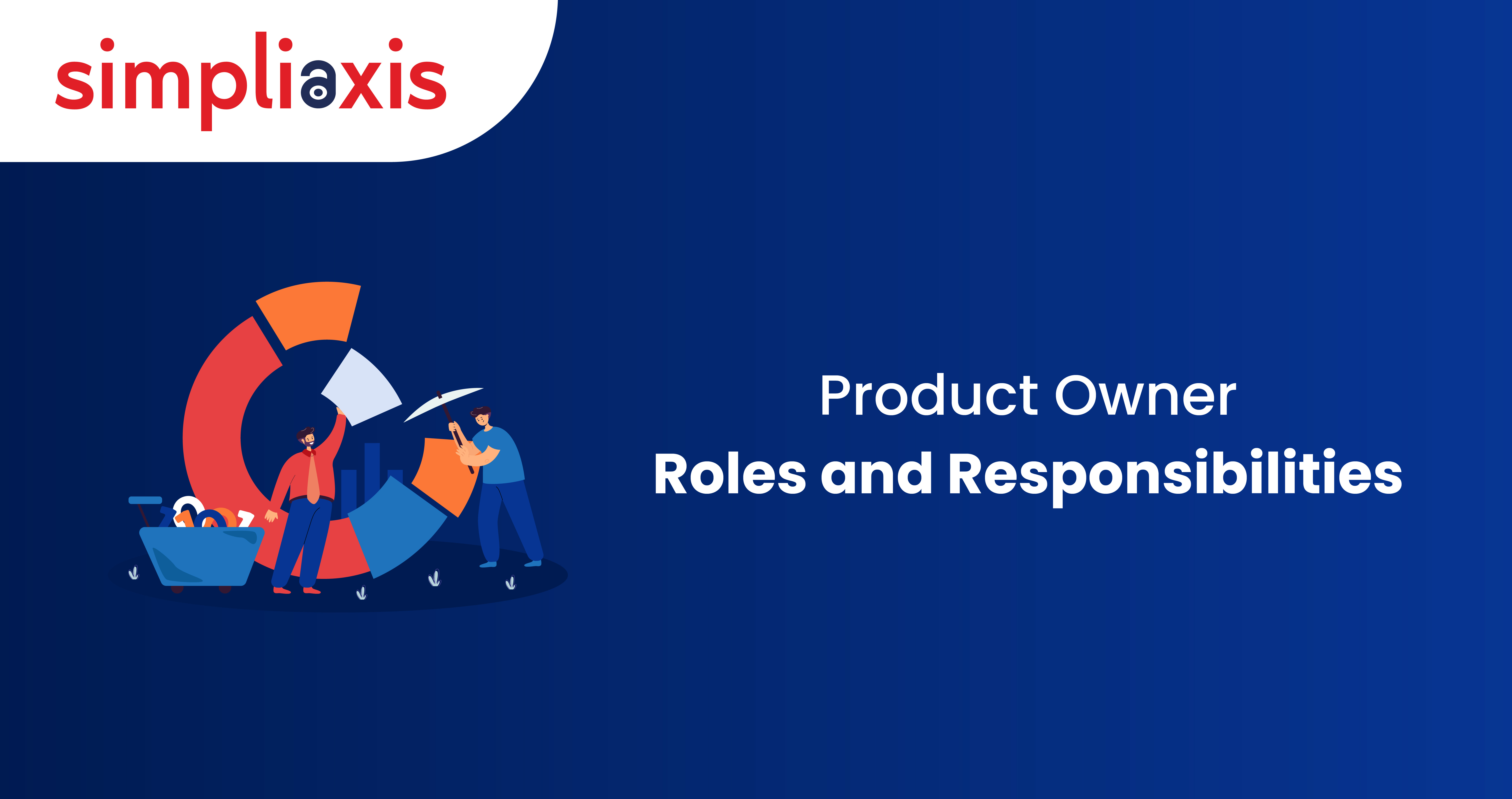Modern businesses require a product owner for their product development process. What are the product owner roles and responsibilities? Here is a twist! As the name suggests, we assumed that the product owner has ownership of the product in the product development cycle. However, in reality, a product owner role and responsibilities are to understand the client's requirements regarding the product and bridge the gap between the product strategy and development. The Product owner creates the strategy in Scrum, and the Scrum master executes the planning. Consequently, the role and responsibility of the product owner depend on the organization's structure and environment. Still, the position can manage business strategy to product design.
This blog will help you comprehend the product owner roles and responsibilities. In addition, you will get more information regarding the job prospects of the product owner in the future. Read the article to know more about the profession that helps you make wise decisions.
Who is the Product Owner?
Most importantly, the product owner job is the newest job in the market. The job position is created for the agile framework in software development companies. The position is gradually getting recognition among other industries using the Scrum methodologies. The agile product owner's responsibilities are to describe the customer's requirements to the development team and to improve the quality of the product developed by the team. As per the Scrum guide, the product owner can help maximize product value across the team and businesses. However, the organization must respect the perception of the product owner.
Simply put, the role and responsibilities of a product owner in some organizations are to be a tactical member of the development team, a strategic representation of customer demands, and to oversee the sprint development. Now, the question is, what is the role of a product owner? The exact function of the product owner depends on the organization's structure and requirements.
Read More: Certified Scrum Product Owner®(CSPO) Roles & Responsibilities
Product Owner Role & Responsibilities
A product owner can utilize their deep market knowledge to strategize the product development and present the vision to the stakeholders. In addition, they maintain a positive collaboration with the team members to achieve the sprint goal. Let’s discuss some of the product owner roles and responsibilities briefly:
Explain Product Vision:
As an Agile product owner, you should work with stakeholders to create a product strategy and repeatedly discuss it with them to understand their viewpoint. The product owner informs the client, managers, and the development team. Consequently, they ensure that the clear vision regarding the product aligns with business goals. A good Product owner keeps everyone on the same page regarding the product development requirements and strategy. Again, they can help the team create a product roadmap and a high-level strategic visual outline that indicates the vision, priorities, and direction for product development.
Manage Product Backlog:
The product owner responsibilities are to manage the product backlog, which helps the Scrum team to complete the strategic direction with the defined roadmap. In addition, they understand the product goal and create a clear product backlog to maximize the business outcomes. However, it is huge work that requires support and collaboration from the other team members. The product owner's role and responsibilities towards the product backlog are to keep it up to date, so that the team understands how the product evolves. So, it is the product owner responsibility to keep the product backlog transparent and understandable. Their steps make sure that the product development cycle stays aligned.
Bridge the Gap:
The product owners bridge the gap between stakeholders and Scrum team members. They must communicate clearly with the stakeholders regarding decision-making and strategy planning. A successful product owner is an expert in understanding and anticipating the client’s needs and creating a strategy. As a product owner, your market knowledge and communication skills will help you grow in your profession. Thus, customer journey mapping enables you to comprehend your customers and create a visual way to recognize the customer experience. As a product owner, you must address the customer’s genuine concern and rectify the process to impress the customer.
Recognize Needs:
Another vital role and responsibility of the product owner is setting priorities. If you change the scope of the next release, it will have a direct effect on the project's time and budget. If the product owner can not make these decisions, the project will be bloated and overburdened. Prioritizing tasks is another important responsibility of the product owner. In addition, the product owner role and responsibilities indicate that they are responsible for managing the project outcomes, expenses, and team collaboration. They play a crucial role in recognizing the customer needs and explaining them properly to the development team for the quality product delivery.
Evaluating Feedback:
The product owner is primarily responsible for monitoring and assessing the product's development at every stage since they bear the ultimate responsibility for the end product. The product owner collects input at every iteration and modifies the product backlog accordingly. Customer feedback helps recognize the current trends and behavior of the market. It allows you to uncover unmet customer needs and help them improve. As a product owner, you must develop a strong relationship with your team and create a positive customer base by comprehending their demands. It offers them a sense of security and trust that someone is always there to listen to their requirements. The product owner roles and responsibilities are to help your scrum team at every stage of the development process, from describing the user journey and creating product designs to mapping product dependencies and communicating your work with stakeholders.
Read More: Product Owner Certification Levels
How to Become a Successful Product Owner?
If you are interested in progressing your career as a product owner, you must have these skills & knowledge:
Product Management:
Knowledge of Product Management helps you oversee product strategy, planning, budgeting, and forecasting for product delivery. It also ensures your expertise in business analysis and product requirements in the target market. Again, product management knowledge improves communication with developers and businesses.
Project Management:
If you know about project management, you can use your skills and tools to reach the project goals. As a product owner, it helps you plan, carry out, monitor, and manage the product life cycle.
Domain Knowledge:
As a product manager, you must have sufficient knowledge about your field to help your job grow. You need to know how to program, make software, use the agile method, the scrum structure, grow a business, and run a project.
Significance of a Product Owner in a Project
The product owner is an essential component in a project. They are responsible for completing the following task in a project:
Product Backlog Prioritization | The product owner decided which tasks and items must be incorporated into the product backlog. In addition, everyone on the team must know what tasks are incorporated into the sprint and how to complete them to achieve the sprint goal. |
Working on Valuable Features | It is the product owner's role and responsibility to ensure that the teams are working on the most critical tasks that help satisfy customer demands. Thus, the product owner needs to participate actively in sprint planning. |
Communicate with Stakeholders: | Stakeholders and customers can discuss their product requirements with the product owner. It is one of the most important product owner role and responsibilities to communicate properly with the stakeholders and understand their perspective to satisfy their product demands. |
Help in Decision-Making Process | It is up to the product owner to make decisions and give direction so that the Scrum team stays focused on the right goals and produces high-quality work. |
Develop Product Roadmap | It is the product owner's responsibility to keep the plan up to date and consider the changing market and customer needs. |
Product Alignment with Business Strategy | The role and responsibility of a product owner are to ensure that the product development process supports the business goal. |
Product Owner vs. Product Manager
Both product managers and owners assist teams in achieving a goal. Therefore, their duties are comparable. Some businesses employ a single individual to fill both tasks because the responsibilities for the two positions sometimes overlap. Nonetheless, many product managers usually do not have product owner responsibilities, and some product owners may have both.
Product managers usually focus on methods to align the product with the company's or customer's goals. They design and evolve the process throughout the product lifecycle, often considering larger corporate objectives. In addition to managing broader aspects like the schedule and anticipated expenses, they also monitor market developments.
Product owners typically concentrate on the activities the development team must accomplish to satisfy those goals.
They communicate with the stakeholders and discuss their specific requirements with the development team to improve product quality. The product owner role and responsibilities signify that they can help enhance the product value through proper communication. Again, they can create user stories that help in user-focused decision-making and development. Thus, in a product development cycle, the product owner plays a crucial role in improving product quality.
Know More: How To Become a Certified Scrum Product Owner®?
Future Trends in Product Owner
Let's talk about what a product owner can do in the future for their job and business:
Incorporating Technology to Enhance Product Ownership
Those who are passionate about technology and creativity would be advised to pursue a profession as product owners. This role has the potent capacity to use technology as a catalyst, directing innovation within the framework of organizational structures and creating new opportunities for product owners in the future.
The product owner's future will always incorporate methodology fundamentals in this dynamic environment. Flexibility and quick thinking are the cornerstones of agility principles. Future product owners must have plans to deal with uncertainty and maintain successful product launches as technology and consumer preferences change.
Customer-Centric Approaches
In the future, product owner roles and responsibilities will be exclusively determined by the preferences and requirements of their target market. Every aspect of product ownership will be guided by customer-centricity as consumer expectations continue to evolve. Therefore, the utilization of data analytics and market research is instrumental in increasing consumer satisfaction and reaching the target market.
In the era of personalization and customization, generic and one-size-fits-all approaches are no longer effective. Future product owners know end users' concerns and comprehend their objectives, behaviors, and challenges.
Remote Product Ownership
The move toward remote work impacts the future scope of product owners. Remote product ownership will become increasingly feasible in the future. As a product owner, you can engage with international teams by leveraging their distinct viewpoints and expertise.
In the future, remote product owners will enable businesses to recruit more creative and innovative workers without worrying about their location.
Use of AI and Automation
Product owners' business practices may change due to automation and artificial intelligence. You can get helpful data-driven suggestions from artificial intelligence (AI)-driven insights that will help product owners in the future to determine how to improve the user experience, which features to prioritize, and how to keep up with market trends.
Combining automation and artificial intelligence elevates the product owner roles and responsibilities to a new degree of sophistication.
Increase in Sustainable Product Ownership
The components of sustainable product ownership are using eco-friendly design principles, making the best use of available resources, and ensuring that products adhere to ethical and environmental standards.
Sustainability is now crucial in all corporate sectors. Thus, sustainable products encourage positive change in several areas, including material selection, waste minimization, and alignment with the principles of the circular economy.
Read More: Product Owner Career Path
How Simpliaxis Helps in the Product Owner Journey
A product Owner must have sufficient knowledge about both the technical capabilities of the product and business logic to comprehend client requirements better and convert them into product requirements. In addition, a product owner roles and responsibilities are far deeper and relatable to product development. They play a critical role in guaranteeing the delivery of high-quality products while optimizing product value following the customer's product vision. Are you serious about the product owner career? Simpliaxis offers CSPO Certification Training from the Scrum Alliance that helps you to get proficiency in comprehending the role and responsibilities of a product owner. Enroll in the course to achieve professional success with a sufficient skill development process.






















